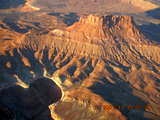
|
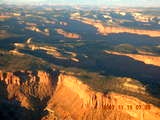
|
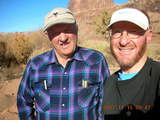
| |
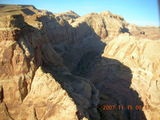
| |||
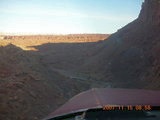
|
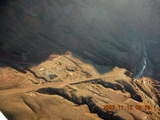
|
UTAH BACK-COUNTRY FLYING II
A Pilot's View of the Back Country
2007 November 15
2008 November 26

|

|

| |

| |||

|

|
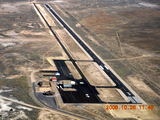 You're an airplane pilot with enough hours to feel comfortable
taking off,
flying and navigating for a couple of hours,
maybe spending some time in a cloud,
and landing an airplane on a strip of asphalt
at your destination,
even if the wind is ten or twenty knots.
Maybe it's a hobby, maybe it's a livelihood.
You've been doing this long enough
there's dust on your first logbook.
What's so exciting about flying into small strips amid big mountains?
You're an airplane pilot with enough hours to feel comfortable
taking off,
flying and navigating for a couple of hours,
maybe spending some time in a cloud,
and landing an airplane on a strip of asphalt
at your destination,
even if the wind is ten or twenty knots.
Maybe it's a hobby, maybe it's a livelihood.
You've been doing this long enough
there's dust on your first logbook.
What's so exciting about flying into small strips amid big mountains?
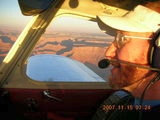 Think of it as a Back-Country rating.
You had to get an instrument rating from the FAA to fly in a cloud.
You had to get a commercial certificate to fly people for money.
They said I had to get a signed endorsement
to fly a retractable-gear airplane and,
more recently, a separate endorsement to fly an airplane
with 200 horsepower or a taildragger.
Each of these calls upon skills beyond
those you get flying a training airplane
from Point A to Point B under good conditions.
More importantly, these circumstances
present challenges that demand extra respect from a pilot
as well as extra skill.
Well, so does Utah's back-country.
Think of it as a Back-Country rating.
You had to get an instrument rating from the FAA to fly in a cloud.
You had to get a commercial certificate to fly people for money.
They said I had to get a signed endorsement
to fly a retractable-gear airplane and,
more recently, a separate endorsement to fly an airplane
with 200 horsepower or a taildragger.
Each of these calls upon skills beyond
those you get flying a training airplane
from Point A to Point B under good conditions.
More importantly, these circumstances
present challenges that demand extra respect from a pilot
as well as extra skill.
Well, so does Utah's back-country.
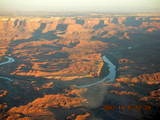 A few years ago I flew into Canyonlands Airport
(CNY)
and the fellow behind the counter said
I should think about a trip to
Hidden Splendor, a tough, little, back-country strip.
For the same reason I read about rock climbing,
ironman triathlons, and racing Bugattis and Porsches,
I got a DVD video called
Out There Flying
and a back-country, dirt-strip directory called
Fly Utah!
to read about this kind of adventure flying.
In my mind,
this was an adventure land of Huskies, Maules,
and other little tail-draggers with big motors and bigger tires.
My Piper Cherokee
140 with 1800 hours on its 29-year-old engine
that flies in and around Phoenix
would have no place in this world.
A few years ago I flew into Canyonlands Airport
(CNY)
and the fellow behind the counter said
I should think about a trip to
Hidden Splendor, a tough, little, back-country strip.
For the same reason I read about rock climbing,
ironman triathlons, and racing Bugattis and Porsches,
I got a DVD video called
Out There Flying
and a back-country, dirt-strip directory called
Fly Utah!
to read about this kind of adventure flying.
In my mind,
this was an adventure land of Huskies, Maules,
and other little tail-draggers with big motors and bigger tires.
My Piper Cherokee
140 with 1800 hours on its 29-year-old engine
that flies in and around Phoenix
would have no place in this world.
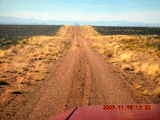 Don't get me wrong.
I'm no stranger to small airports.
I learned to fly on a
dirt strip
and I've
kept
my airplane and
bought
my fuel
at places with 1600 feet or less of usable runway.
I've flown all over the Rocky Mountains of western Colorado.
I keep count of how many airports where I've landed
and that tally was over 300 in 39 states
and 25 of those were grass, dirt, gravel, sand, or otherwise unpaved.
Still, I was more intimidated than curious for a while.
Don't get me wrong.
I'm no stranger to small airports.
I learned to fly on a
dirt strip
and I've
kept
my airplane and
bought
my fuel
at places with 1600 feet or less of usable runway.
I've flown all over the Rocky Mountains of western Colorado.
I keep count of how many airports where I've landed
and that tally was over 300 in 39 states
and 25 of those were grass, dirt, gravel, sand, or otherwise unpaved.
Still, I was more intimidated than curious for a while.
The end of the story is that I've had two wonderful flying trips, last year and this year, into the Utah back-country and learned some new meanings for old aviation terms like "short field landing," "short field takeoff," "soft field takeoff," "crosswind landing," "approach," "departure," and "navigation" in this wonderful landscape.
The notion of descending into an airport I couldn't see was
novel
to me.
Having canyon walls on both sides of me was also new and scary.
My
heart
was
pounding.
The whole Hidden Splendor experience
demanded a new level of flying performance.
After stopping for a while,
we noted Mexican Mountain has a short runway
but an easy climb once airborne.
At this point LaVar decided to give me some back-country training
by flying the Green River canyon
just over the water.
This is a beautiful flight and it took me a while
to get used to having water right below me
and rocks on both sides.
The river has its geology and its canyon has a rhythm.
It took a while but I began to understand the rhythm
and to follow the river more easily.
We flew over Mineral Canyon
(UT75)
but did not land because the ground there was too soft.
Actually, landing would have been easy,
but takeoff would have been difficult in my airplane.
On the way back to Hanksville,
LaVar suggested I land at Angel Point
(WPT706)
on my way back to Canyonlands.
I felt very proud that I had earned a back-country solo landing,
at least an unobstructed back-country strip
on a clear day with no wind.
In the four hours we spent in and around my airplane,
LaVar taught me to appreciate the beauty of the Utah back-country
and to appreciate the skills needed to fly safely in it.
If perfect landings and takeoffs are the standard of the day,
then LaVar showed me flying at its best.
In addition to the two landings at normal airports
we did eight back-country-airstrip landings.
Finally, we did take my bird into the air
so I could practice the approach to Hidden Splendor.
I feel I could land there solo
and LaVar feels I could land there solo.
When I get my new 160-HP engine,
I look forward to doing that.
The
FAA
may not recognize any official endorsement to land
at Hidden Splendor, but I do.
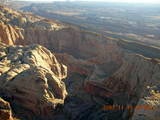
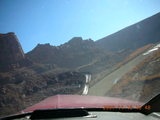
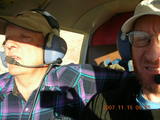
Meeting LaVar Wells
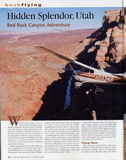 There was an article in
Pilot Getaways Magazine about Hidden Splendor.
That pushed my curiosity and interest up enough
to figure the worst they could do is laugh at me.
I called Red Tail Aviation,
the FBO at
CNY
and was referred to somebody who referred me to LaVar Wells
who didn't laugh at me.
He even suggested that a Cherokee 140 could do just fine.
I found out after flying together,
his airplane in 2007 November
was a Cessna 172 with 145 horsepower,
about the same weight and power I had.
There was an article in
Pilot Getaways Magazine about Hidden Splendor.
That pushed my curiosity and interest up enough
to figure the worst they could do is laugh at me.
I called Red Tail Aviation,
the FBO at
CNY
and was referred to somebody who referred me to LaVar Wells
who didn't laugh at me.
He even suggested that a Cherokee 140 could do just fine.
I found out after flying together,
his airplane in 2007 November
was a Cessna 172 with 145 horsepower,
about the same weight and power I had.
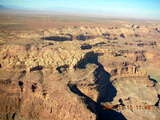 LaVar has a terrific reputation
and it didn't take long to see why.
Not only does he love the back-country,
not only does he love sharing the back-country,
he loves teaching people to fly in it.
I showed up at Hanksville
(HVE)
on 2007 November 15 at 8:00 in the morning,
a wonderful morning flight from
CNY.
After a brief discussion with me about what we would do,
we climbed into my Cherokee,
he pointed to a dirt crosswind runway,
and I practiced short-field landings and takeoffs on it.
I did well enough for him to take me and my airplane
into some exciting places.
LaVar has a terrific reputation
and it didn't take long to see why.
Not only does he love the back-country,
not only does he love sharing the back-country,
he loves teaching people to fly in it.
I showed up at Hanksville
(HVE)
on 2007 November 15 at 8:00 in the morning,
a wonderful morning flight from
CNY.
After a brief discussion with me about what we would do,
we climbed into my Cherokee,
he pointed to a dirt crosswind runway,
and I practiced short-field landings and takeoffs on it.
I did well enough for him to take me and my airplane
into some exciting places.
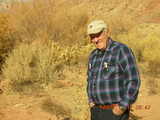 Good teaching requires walking a thin line.
The student should learn enough humility to learn what is taught
while retaining enough confidence to feel good about using it.
I felt pretty good landing my Cherokee on that short strip
with the landing flare stall breaking right
where the numbers would be if the runway had them,
a nice 500-foot landing.
The second was a bit longer, but still enough to make me feel good.
LaVar gave me a pointer or two
and let me feel comfortable in the skill I have.
Good teaching requires walking a thin line.
The student should learn enough humility to learn what is taught
while retaining enough confidence to feel good about using it.
I felt pretty good landing my Cherokee on that short strip
with the landing flare stall breaking right
where the numbers would be if the runway had them,
a nice 500-foot landing.
The second was a bit longer, but still enough to make me feel good.
LaVar gave me a pointer or two
and let me feel comfortable in the skill I have.
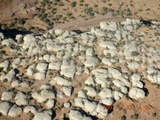 Imagine growing up in this forbidding landscape.
Does anything so strange ever become comfortable?
One booklet I saw years ago
said you should see Utah with one closed
so it only seems half as strange.
The natives of this land are prickly plants
and odd-looking animals
while we are guests who may visit this wilderness
and then should go back home.
This land is LaVar's home and he fits right in.
Imagine growing up in this forbidding landscape.
Does anything so strange ever become comfortable?
One booklet I saw years ago
said you should see Utah with one closed
so it only seems half as strange.
The natives of this land are prickly plants
and odd-looking animals
while we are guests who may visit this wilderness
and then should go back home.
This land is LaVar's home and he fits right in.
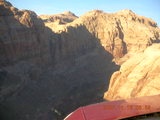
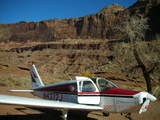
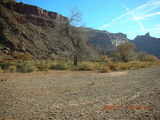
Flying with LaVar Wells – Part One
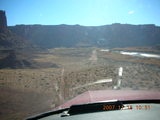 Frank Fine,
my primary instructor of twenty-two years ago,
takes joy in aviation and shares that joy exquisitely with
his many students, primary, instrument, and other.
"Aviation will give you many happy years if you respect it,"
he told his students at our first flying lessons
and he shared both the joy and the respect parts of it.
LaVar feels and shares the same joy in flying the back-country
and shares the same respect for the specific hazards
of the back-country.
Frank Fine,
my primary instructor of twenty-two years ago,
takes joy in aviation and shares that joy exquisitely with
his many students, primary, instrument, and other.
"Aviation will give you many happy years if you respect it,"
he told his students at our first flying lessons
and he shared both the joy and the respect parts of it.
LaVar feels and shares the same joy in flying the back-country
and shares the same respect for the specific hazards
of the back-country.
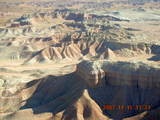 I met LaVar on 2007 November 15 with some nervousness.
Here I am a city slicker with a city-slicker airplane
about to face some serious non-city flying.
LaVar was reassuring and utterly pleasant to fly with.
He climbed into the right seat of my Cherokee
and had me demonstrate my short-field skills
on the dirt crosswind runway at Hanksville
(HVE).
I did well enough to earn the prize,
landing at Hidden Splendor
(WPT660
on the
GH-UT Utah WAC Supplement Chart
that is available with
Fly Utah!).
I met LaVar on 2007 November 15 with some nervousness.
Here I am a city slicker with a city-slicker airplane
about to face some serious non-city flying.
LaVar was reassuring and utterly pleasant to fly with.
He climbed into the right seat of my Cherokee
and had me demonstrate my short-field skills
on the dirt crosswind runway at Hanksville
(HVE).
I did well enough to earn the prize,
landing at Hidden Splendor
(WPT660
on the
GH-UT Utah WAC Supplement Chart
that is available with
Fly Utah!).
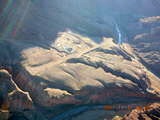 We climbed northeast out of Hanksville
and ten or fifteen minutes later came to
the San Rafael Reef, a wall of rock
created by geologic forces of unimaginable power.
Muddy Creek goes through the reef,
probably because it went there before the upthrust
and eroded a canyon for itself as the rocks rose.
The approach to Hidden Splendor is interesting:
enter the canyon at 6000 feet with rocks on both sides,
sharp left in the canyon,
sharp right just over a small mesa,
keep close to the left canyon wall curving right,
and the strip appears quickly on the right side.
Its runway is 1800 feet along a small mesa
and there's even enough room to go around if you have to.
He did the first approach for me,
so I could learn the approach and take pictures,
and had me land on the strip itself.
The second time it was talk only from LaVar
and I was busy flying the canyon approach.
We climbed northeast out of Hanksville
and ten or fifteen minutes later came to
the San Rafael Reef, a wall of rock
created by geologic forces of unimaginable power.
Muddy Creek goes through the reef,
probably because it went there before the upthrust
and eroded a canyon for itself as the rocks rose.
The approach to Hidden Splendor is interesting:
enter the canyon at 6000 feet with rocks on both sides,
sharp left in the canyon,
sharp right just over a small mesa,
keep close to the left canyon wall curving right,
and the strip appears quickly on the right side.
Its runway is 1800 feet along a small mesa
and there's even enough room to go around if you have to.
He did the first approach for me,
so I could learn the approach and take pictures,
and had me land on the strip itself.
The second time it was talk only from LaVar
and I was busy flying the canyon approach.
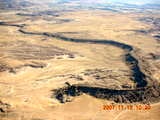 After Hidden Splendor we went to Mexican Mountain.
Along the way,
LaVar talked about the geology of the region,
uplifted reefs and rock layers
and dry riverbeds that eroded more slowly
and were higher than their surroundings.
Without the narrow canyon approach,
Mexican Mountain
(WPT692
on the GH-UT Chart)
seemed almost leisurely
until the short airstrip appeared suddenly on a turn
from base to final.
After Hidden Splendor we went to Mexican Mountain.
Along the way,
LaVar talked about the geology of the region,
uplifted reefs and rock layers
and dry riverbeds that eroded more slowly
and were higher than their surroundings.
Without the narrow canyon approach,
Mexican Mountain
(WPT692
on the GH-UT Chart)
seemed almost leisurely
until the short airstrip appeared suddenly on a turn
from base to final.
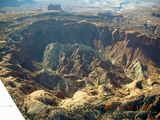 We saw Upheaval Dome from the air.
Up close from the ground it doesn't make sense,
but the whole shape comes into view from above.
Remember the scene in the Matthew Broderick version
of "Godzilla" where ther're a bunch of guys standing in a depression
saying they had seen no sign of a giant-lizard monster?
As I remember it,
the camera angle widens and the movie watchers see
that they're standing in a giant footprint.
We saw Upheaval Dome from the air.
Up close from the ground it doesn't make sense,
but the whole shape comes into view from above.
Remember the scene in the Matthew Broderick version
of "Godzilla" where ther're a bunch of guys standing in a depression
saying they had seen no sign of a giant-lizard monster?
As I remember it,
the camera angle widens and the movie watchers see
that they're standing in a giant footprint.
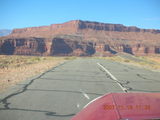 We landed at Hite
(UT03)
at the north end of Lake Powell.
The runway there has four segments that almost line up
and the best approach is not from Lake Powell to the south
but from the Dirty Devil River.
Like many back-country airstrips, the straight-in approaches
are blocked by rocks in both directions.
We landed at Hite
(UT03)
at the north end of Lake Powell.
The runway there has four segments that almost line up
and the best approach is not from Lake Powell to the south
but from the Dirty Devil River.
Like many back-country airstrips, the straight-in approaches
are blocked by rocks in both directions.
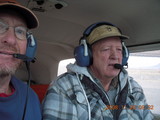
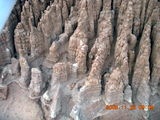
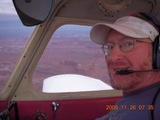
Flying with LaVar Wells – Part Two
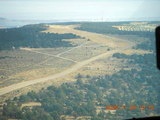 My next trip to Moab,
I called LaVar to set up another back-country lesson
on 2008 November 26.
I realize at one lesson a year I'm not going to be an expert,
but I like to think some of my learning would stick for a year.
LaVar felt my pilot skills were quite good enough,
but my airplane's engine is not performing well enough
to get out of some of the places he wanted to take me.
I have a new and stronger engine on order for 2009 February,
but I'm still flying my 1979 engine.
It's working fine, but it doesn't have the
power
for these short, high airstrips.
LaVar offered his airplane instead
with him in the left seat
instructing through example and talk
rather than right-seat, back-seat driving.
It would be a chance to see an expert fly out here.
My next trip to Moab,
I called LaVar to set up another back-country lesson
on 2008 November 26.
I realize at one lesson a year I'm not going to be an expert,
but I like to think some of my learning would stick for a year.
LaVar felt my pilot skills were quite good enough,
but my airplane's engine is not performing well enough
to get out of some of the places he wanted to take me.
I have a new and stronger engine on order for 2009 February,
but I'm still flying my 1979 engine.
It's working fine, but it doesn't have the
power
for these short, high airstrips.
LaVar offered his airplane instead
with him in the left seat
instructing through example and talk
rather than right-seat, back-seat driving.
It would be a chance to see an expert fly out here.
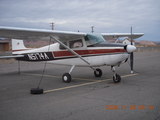 In 1956 LaVar's father bought
N5174A, Cessna 172 serial number 174,
brand new in Wichita, Kansas, and brought it back to Utah.
A few years later it was modified with a 180-horsepower engine,
a constant-speed propeller, and
short-takeoff-and-landing (STOL) modifications for the wings.
It was sold years ago and recently LaVar
bought it back.
"This is the perfect airplane for the mission"
of flying in the Utah back-country.
In 1956 LaVar's father bought
N5174A, Cessna 172 serial number 174,
brand new in Wichita, Kansas, and brought it back to Utah.
A few years later it was modified with a 180-horsepower engine,
a constant-speed propeller, and
short-takeoff-and-landing (STOL) modifications for the wings.
It was sold years ago and recently LaVar
bought it back.
"This is the perfect airplane for the mission"
of flying in the Utah back-country.
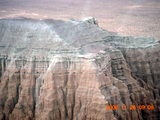 So I climbed into the right seat and we took off together
from Hanksville into the beautiful back-country.
There are many measures of an airplane pilot,
holding altitude, partial panel flight in clouds,
keeping navigation needles perfectly centered,
navigating in various ways,
making perfect coordinated turns,
takeoffs, and landings.
For a variety of reasons,
I have found that landing an airplane
in lots of different places
(and taking off again)
is how I see myself as a better pilot.
LaVar seems to feel the same way.
So I climbed into the right seat and we took off together
from Hanksville into the beautiful back-country.
There are many measures of an airplane pilot,
holding altitude, partial panel flight in clouds,
keeping navigation needles perfectly centered,
navigating in various ways,
making perfect coordinated turns,
takeoffs, and landings.
For a variety of reasons,
I have found that landing an airplane
in lots of different places
(and taking off again)
is how I see myself as a better pilot.
LaVar seems to feel the same way.
Hidden Splendor
(WPT660)
Mexican Mountain
(WPT692)
Ceder Mountain
(WPT679)
Sage Brush
(WPT687)
Sand Wash
(WPT676)
Mineral Canyon
(UT75)
Happy Canyon
(UT97)
Dirty Devil
(WPT764)
Each was as perfect as I could judge with
approach and airspeed aimed at a precise landings point
for a gentle touchdown and an easy rollout.
Landings not at the immediately closest point
were done to avoid rocky terrain
that might damage a nosewheel or propeller.
Each approach was explained to me as we did it,
some were normal traffic patterns
while others were more adventurous paths to a landing.
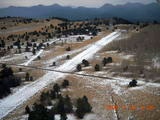 We did not land at Tavaputz Ranch,
elevation 9200 feet, length 2500 feet.
From a dry runway, N5174A could have gotten us out of there,
but there was snow around and the runway would have been muddy.
"The superior pilot exercises his superior judgment
to avoid exercising his superior skill."
Just as the decision to use LaVar's N5174A
instead of my N4372J was superior judgment,
so was the decision to overfly a muddy runway
rather than to land on it.
We did not land at Tavaputz Ranch,
elevation 9200 feet, length 2500 feet.
From a dry runway, N5174A could have gotten us out of there,
but there was snow around and the runway would have been muddy.
"The superior pilot exercises his superior judgment
to avoid exercising his superior skill."
Just as the decision to use LaVar's N5174A
instead of my N4372J was superior judgment,
so was the decision to overfly a muddy runway
rather than to land on it.
 We stopped in Sand Wash for bit to enjoy the scenery
before heading back south to Canyonlands for fuel.
The leg from Sand Wash to Canyonlands
was flown mostly in the Green River canyon
as I had done a year earlier.
Instead of being busy maintaining altitude over the water
and spacing between the canyon walls,
I was able to enjoy the utter beauty of this place.
The canyon's rhythm was apparent
as we flew it smoothly and perfectly coordinated.
Most of us pilots like to think all our turns are perfect,
but we slip and slide a little and the ball wanders a bit for us.
As passengers, we can tell
when a pilot actually does maintain coordinate turns.
We stopped in Sand Wash for bit to enjoy the scenery
before heading back south to Canyonlands for fuel.
The leg from Sand Wash to Canyonlands
was flown mostly in the Green River canyon
as I had done a year earlier.
Instead of being busy maintaining altitude over the water
and spacing between the canyon walls,
I was able to enjoy the utter beauty of this place.
The canyon's rhythm was apparent
as we flew it smoothly and perfectly coordinated.
Most of us pilots like to think all our turns are perfect,
but we slip and slide a little and the ball wanders a bit for us.
As passengers, we can tell
when a pilot actually does maintain coordinate turns.
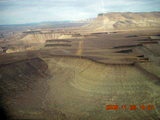 The price of pilot perfection is practice.
I recall somebody telling a great musician,
"I would give my life to play like you do,"
to which he replied, "Madam, I have."
LaVar has flown this country months, years, and decades.
His love for it shows in everything he does in the air
and his repect for it shows in how he does it.
I may have learned more about flying as his passenger
than I would actively flying myself with verbal instruction.
The price of pilot perfection is practice.
I recall somebody telling a great musician,
"I would give my life to play like you do,"
to which he replied, "Madam, I have."
LaVar has flown this country months, years, and decades.
His love for it shows in everything he does in the air
and his repect for it shows in how he does it.
I may have learned more about flying as his passenger
than I would actively flying myself with verbal instruction.
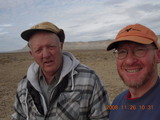 We also checked out LaVar's new project,
building a solar-powered well to get water out of the ground
for cattle to drink with photovoltaic panels.
The panels were there as was a round, blue, pool-like area
and we could see the workmen around a fire.
You don't have to be a "tree hugger" to appreciate
how nice it is when you can let the desert sun
do the work to provide drinking water.
We also checked out LaVar's new project,
building a solar-powered well to get water out of the ground
for cattle to drink with photovoltaic panels.
The panels were there as was a round, blue, pool-like area
and we could see the workmen around a fire.
You don't have to be a "tree hugger" to appreciate
how nice it is when you can let the desert sun
do the work to provide drinking water.
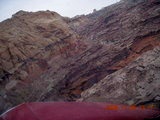
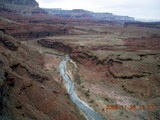
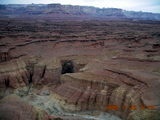
Back-Country Summary
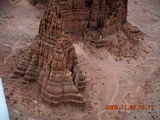 So what have I learned in earning my Utah-back-country
solo endorsement?
I've learned one more aspect of flying an airplane
that I didn't know before I flew here.
Precise flying is a prerequisite for back-country flight.
Canyon approaches and short runways require good flying skill.
One-way airstrips and un-flyable gusty winds require good judgment.
Learning from more-experienced pilots is an essential part
of a back-country pilot education.
So what have I learned in earning my Utah-back-country
solo endorsement?
I've learned one more aspect of flying an airplane
that I didn't know before I flew here.
Precise flying is a prerequisite for back-country flight.
Canyon approaches and short runways require good flying skill.
One-way airstrips and un-flyable gusty winds require good judgment.
Learning from more-experienced pilots is an essential part
of a back-country pilot education.
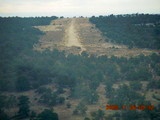 The corollary of precise and skilled flying is respect.
Knowing our limitations is essential
when exceeding them is punished by crashing into rocks.
This is no place for horsing around.
If you want to see the canyons, formations, and hide-away airstrips
of Utah's back-country,
then you should leave any cowboy attitudes behind.
The corollary of precise and skilled flying is respect.
Knowing our limitations is essential
when exceeding them is punished by crashing into rocks.
This is no place for horsing around.
If you want to see the canyons, formations, and hide-away airstrips
of Utah's back-country,
then you should leave any cowboy attitudes behind.
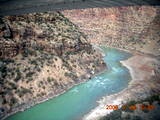 The reward for this discipline is
the immediate and immense beauty of the back-country.
I've landing in a lot of places and flown over a lot of scenery
and there is nothing else like the places I flew here.
Now that I have flying experience
and the benefit of LaVar's teaching,
I do want to see the canyons, formations, and hide-away airstrips
of Utah's back-country.
There are formations and shapes here
that bring intense joy to pilot and passengers alike.
LaVar's long experience tells me
the joy of this place can last as long as we fly here.
I look forward to coming back here.
The reward for this discipline is
the immediate and immense beauty of the back-country.
I've landing in a lot of places and flown over a lot of scenery
and there is nothing else like the places I flew here.
Now that I have flying experience
and the benefit of LaVar's teaching,
I do want to see the canyons, formations, and hide-away airstrips
of Utah's back-country.
There are formations and shapes here
that bring intense joy to pilot and passengers alike.
LaVar's long experience tells me
the joy of this place can last as long as we fly here.
I look forward to coming back here.
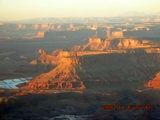
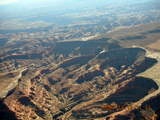
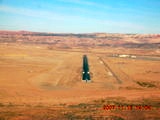
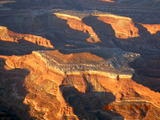
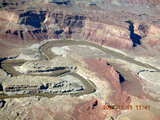
4:25:02 Mountain Standard Time
(MST).
31522 visits to this web page.